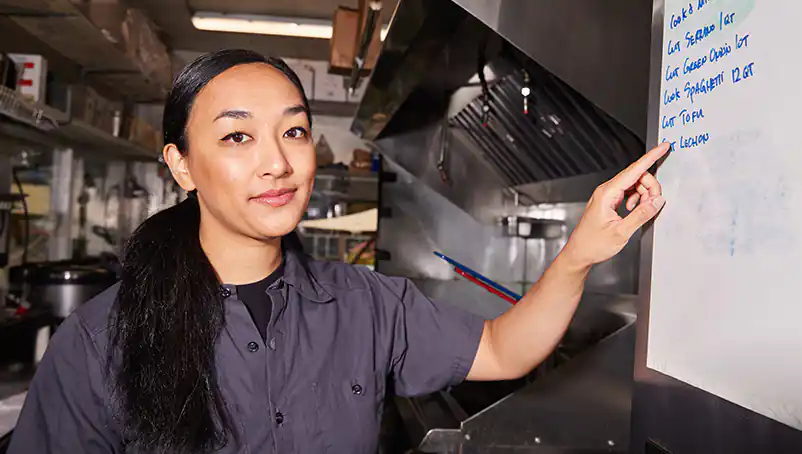Creating a restaurant marketing plan — whether it’s for a restaurant or another type of food business can feel daunting.
You need a marketing plan to get the word out about your business, but you might not know where to start because your other daily responsibilities don’t magically disappear.
Good news.
You don’t have to have a massive amount of money or a wacky commercial to stand out from the crowd. You only need to authentically highlight what makes your restaurant unique.
The most successful restaurant marketing plan is the one that fits your time and budget.
We put together a 7-step guide to help you find your restaurant’s voice and audience. Learn about each step below and how you can discover new restaurant marketing ideas.
1. Consider hiring a professional marketer right from the start
Here’s where having a business plan comes in handy.
Your budget might not be big enough to hire a full-time marketing team, but that doesn’t mean you have to develop a restaurant marketing plan on your own.
Use your network to find a marketer. Ask them to develop the structure for a marketing plan: balancing your efforts on social media, email offers and in-person promotions.
Then, either you or a trusted team member can execute the steps of the plan. This will help you learn how to examine the financial return of different marketing efforts and provide a potential growth opportunity for an employee.
2. Entice your customers through your menu
Look at your menu. It’s a shorthand for your restaurant’s identity. The dishes you choose to serve — like a recipe passed down for generations — will tell your story, but only if customers can find your menu.
A simple and cost-effective first step in restaurant marketing is to make sure your menu is readily available and easy to read on your website.
A survey from MGH, a restaurant marketing firm, found that 77% of people visited a restaurant’s website before stepping inside the door.
Build anticipation with mouth-watering descriptions and clearly mark potential allergens to make it easier for diners to pick your restaurant. Take the same care with how you present your menu in the dining room, as the trend of digital menus isn’t going anywhere.
3. Share your food online and utilize social media
Diners eat first with their eyes.
Showcase your menu by investing your time (and budget, if it’s available) in appetizing pictures and videos. With the right lighting and a smartphone, you can take dynamic food photos to share on social media sites like Instagram or Facebook.
Likewise, a quick video tutorial about how you make a dish can help you catch the eye of would-be diners on video-sharing sites like TikTok or YouTube.
Behind the scenes footage can also be a powerful way to connect with costumes and build a following.
“People like to take a little bit of ownership of what they're buying into,” says Gerard Terrell, co-owner of Terell’s Eat The Bone BBQ near Chicago. “You can make them a part of the process with content like that.”
Take note: This step is where you begin to learn about your audience. Try highlighting different menu items on different platforms. See what resonates. Pay attention to what’s shared and what brings people to your restaurant.
Listen to feedback and respond positively — even if you get negative comments.
4. Build relationships with your customers
While it’s important to bring new folks in the door, take the time to get to know your fans.
Find your regulars — the lifeblood of every restaurant — and learn more about what keeps them coming back to your business. This can also lead to valuable word-of-mouth marketing.
“With all new clients, I tell them that my goal is to form a relationship,” says Mimi Hood, founder of Mimi’s Mocha Treats, a specialty cake business near Washington, D.C. “I don't want to just take your order. I want to follow you through all the amazing highlights in your life.”
“I want you to tell your best friend who's getting married about me,” she says. “I want you to tell your cousin who's having her third baby about me for her baby shower.”
5. Learn what guests love about your restaurant
Once people start showing up, do a little research to see what diners are ordering. Look at your point-of-sale (POS) system to understand the most popular dish. That dish is the new star of your restaurant marketing campaign.
Bands play the hits when they go on tour. Go ahead. Take that favorite dish on the road.
Reach out to local television stations and offer to do a cooking demonstration on a morning show. Look for the producer’s name in the credits and send them an email. Or, instead of traditional media, partner with a creator or online influencer to share the secret behind your chicken tenders.
A signature dish can define a restaurant. It can build your reputation in a city. Think of the French fries on sandwiches at Primanti Bros. A signature dish is a conversation starter, a singular reason people have to dine at your restaurant.
6. Reward diners for visiting your restaurant
Develop a loyalty program that provides incentives for dining more often or on certain days.
Sometimes a simple punch card that provides one free item after purchasing 10 items, can be the difference between return customers at counter service businesses.
You can also send guests email coupons in a text or tease new dishes in an email newsletter. Think of it as an extension of hospitality, especially if your business has been shifting away from in-person dining to pick-up or delivery.
Loyalty programs strengthen connections with your customers and encourage them to come back. Square, the payment processing platform, found that 90% of restaurateurs plan on using customer engagement practices.
7. Use what you learn about your customers to refresh your menu
Small, independent restaurants can still use sophisticated marketing techniques. The final step in your restaurant marketing plan is to listen to what diners are telling you and apply it to your menu.
If items aren’t selling, take them off your menu.
While the trend of trimming menus can help you navigate potential supply chain issues or make it easier when you’re understaffed, it also allows you to refresh your menu. This gives you something you can share with new and existing customers.
NEXT makes restaurant insurance easy, so you can focus on marketing
While you’re busy telling the story of your restaurant, you don’t want any surprises in your business.
NEXT offers customized restaurant insurance packages that are fast, easy and affordable.
You can get a quote, choose a policy and get your certificate of insurance online in about 10 minutes.
If you have questions, our team of licensed, U.S.-based insurance professionals are ready to help.






